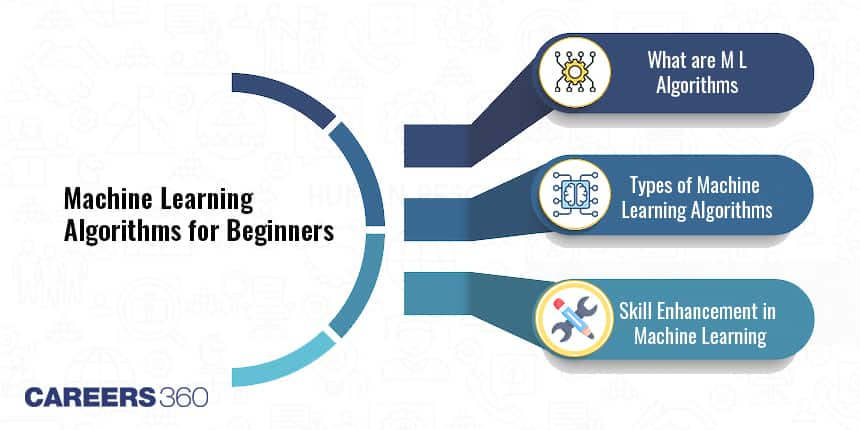FLAME University | MBA 2025
NAAC A++ Grade | Only Indian University member in the Global Liberal Arts Alliance
Machine learning, a pivotal facet of artificial intelligence, has emerged as a transformative force, reshaping how we approach complex challenges and make informed decisions. In this age of data abundance, the role of machine learning algorithms cannot be overstated. These algorithms, like guiding beacons, illuminate the path to gleaning patterns from data and making accurate predictions.

For those starting to understand and study machine learning, understanding the fundamental machine learning algorithms is an essential first step. In this article, we will introduce you to machine learning algorithms, elucidate their varied types, and underscore how acquiring proficiency in these algorithms can amplify your competence in this field.
To gain further expertise in this field, you can also go through the list of Online Machine Learning Courses and Certifications listed on our our website.
Machine learning algorithms are sets of rules that enable computers to learn and make predictions or decisions based on data. They are fundamental tools in machine learning and are vital for both beginners and experienced practitioners.
Also Read:
Machine learning algorithms can be broadly categorised into three types: supervised learning, unsupervised learning, and reinforcement learning. In this article, we will focus on supervised machine learning types of algorithms, specifically those used for classification and regression tasks.
1. Supervised Learning Algorithms: In supervised learning, the algorithm is trained on labelled data.What this means is that you already know what each data column means and represents. It learns from this data and can make predictions or classifications on new, unseen data. Examples include Linear Regression, Decision Trees, and Support Vector Machines.
2. Unsupervised Learning Algorithms: Unsupervised learning deals with unlabeled data. The algorithm aims to discover patterns, clusters, or structures within the data. Common unsupervised algorithms are K-Means Clustering and Principal Component Analysis (PCA).
3. Reinforcement Learning Algorithms: Reinforcement learning focuses on training agents to take actions in an environment to maximise rewards. Popular algorithms include Q-Learning and Deep Q Networks (DQN).
Also Read:
Now, let us dive into the machine learning algorithms list that every beginner should be familiar with:
Machine Learning Classification Algorithms: Classification algorithms are used to categorise data into different classes or groups. These algorithms include decision trees, support vector machines, and k-nearest neighbours.
Linear Regression: Linear regression is a fundamental algorithm for supervised learning. It is used in scenarios where you want to predict a continuous numeric value based on input features. The algorithm fits a linear equation to the data, creating a straight line that best represents the relationship between the features and the target variable. This is commonly employed in applications like predicting house prices based on features like size, location, and number of bedrooms.
Logistic Regression: Unlike linear regression, logistic regression is used for binary classification tasks. It estimates the probability that a given input belongs to a particular category. For instance, it is used in spam email detection, where it predicts whether an email is spam (1) or not (0) based on its features. Here is a quick python code on the actual implementation of Logistic Regression.
from sklearn.linear_model import LogisticRegression
from sklearn.model_selection import train_test_split
from sklearn.metrics import accuracy_score, confusion_matrix, classification_report
import numpy as np
# First begin by generating your sample data
X, y = np.random.rand(100, 2), (X[:, 0] + 2 * X[:, 1] > 1).astype(int)
# Split the data into train and test
X_train, X_test, y_train, y_test = train_test_split(X, y, test_size=0.2, random_state=42)
# Fit the logistic regression model
model = LogisticRegression().fit(X_train, y_train)
# Make predictions
y_pred = model.predict(X_test)
# Evaluate the results
accuracy = accuracy_score(y_test, y_pred)
confusion = confusion_matrix(y_test, y_pred)
classification_rep = classification_report(y_test, y_pred)
print(f"Accuracy: {accuracy}\nConfusion Matrix:\n{confusion}\nClassification Report:\n{classification_rep}")
Decision Trees: Decision Tree Algorithm in Machine Learning are versatile and easy-to-understand algorithms used in both classification and regression tasks. They work by splitting the data into subsets based on the most significant attribute at each node. The tree structure allows for visual interpretation and insight into how decisions are made. Decision trees are used in areas such as customer churn prediction, credit scoring, and medical diagnosis.
Random Forest: Random Forest is an ensemble method that combines multiple decision trees to improve accuracy and reduce overfitting. It is known for its robustness and versatility. By aggregating predictions from various trees, it often provides more accurate results. Random Forest is commonly applied in areas like image classification and anomaly detection.
Support Vector Machines (SVM): SVM is a powerful algorithm for classification tasks. It aims to find the optimal hyperplane that best separates data points into different classes. SVM is effective in scenarios like image classification, text classification, and hand-written digit recognition.
K-Nearest Neighbors (KNN): KNN is a simple yet effective algorithm for both classification and regression tasks. It works based on the proximity of data points. In classification, it assigns the class that is most common among the k-nearest neighbours. KNN is used in recommendation systems, image recognition, and more.
K-Means Clustering: K-Means is a popular unsupervised algorithm for clustering data into distinct groups. It groups data points based on their similarity and is widely used in customer segmentation, anomaly detection, and image compression.
Principal Component Analysis (PCA): PCA is an unsupervised algorithm used for dimensionality reduction and feature extraction. It transforms high-dimensional data into a lower-dimensional representation, reducing complexity while preserving important information. PCA is applied in fields like image recognition and data compression.
Naïve Bayes: Naïve Bayes is a probabilistic algorithm primarily used for text classification tasks. It is based on Bayes' theorem and makes the "naïve" assumption of independence among features. It is frequently employed in applications like spam detection and sentiment analysis.
Neural Networks: Neural networks, particularly deep learning, represent a versatile and powerful approach to various machine learning tasks. These networks consist of interconnected layers of nodes that can learn complex patterns in data. Neural networks are widely used in image recognition, natural language processing, autonomous vehicles, and more.
Learning these essential ML algorithms is a crucial step in becoming proficient in machine learning. It empowers you to address a variety of problems, interpret algorithm results, and build a strong foundation for deeper machine learning exploration.
Also Read:
Machine learning algorithms are often categorised based on their applications and functions. These categories include classification, regression, clustering, dimensionality reduction, and more.
Machine learning is at the heart of data science. By understanding and applying machine learning algorithms, data scientists can unlock valuable insights from data, make data-driven decisions, and create predictive models.
The choice of algorithm in machine learning depends on the specific problem you are trying to solve. Different algorithms are suited for different tasks, and understanding their strengths and weaknesses is crucial for making the right choice.
Learning these essential algorithms is a crucial step in becoming proficient in machine learning. Here is how it can enhance your skills:
- Problem-Solving: Each algorithm addresses specific types of problems. Knowing when to apply which algorithm is a critical skill.
- Interpretation: Understanding the inner workings of these algorithms allows you to interpret their results and validate their outputs.
- Versatility: These algorithms form the building blocks for more advanced techniques. Mastering them provides a strong foundation for exploring deeper aspects of machine learning.
Related: Machine Learning Certification Courses by Top Providers
As a beginner in machine learning, all machine learning algorithms mentioned above provide you with a solid foundation. They are relatively easy to understand and implement, making them ideal for those starting their machine learning journey.
Machine learning is an exciting field with immense potential to transform industries and drive innovation. By mastering the top 10 machine learning algorithms and choosing the right learning program, you will be well on your way to making valuable contributions in this ever-evolving field. Whether you are interested in data analysis, predictive modelling, or AI development, these algorithms will be your trusty companions in the world of machine learning.
Machine learning algorithms are sets of rules that enable computers to learn and make predictions or decisions based on data. They are vital for beginners because they provide the foundation for solving real-world problems by extracting patterns from data and making informed decisions.
The choice of the algorithm depends on the nature of your data and the problem you are trying to solve. For example, if you are predicting a continuous value, linear regression might be suitable. Understanding the strengths and weaknesses of each algorithm is key to making the right choice.
No, these algorithms are accessible to anyone interested in machine learning. While programming skills are helpful, many tools and platforms offer user-friendly interfaces for beginners. Learning these algorithms can benefit a wide range of professionals, from marketers to healthcare practitioners.
Many online platforms offer courses, tutorials, and certifications in machine learning. Consider platforms like Coursera, edX, Udacity, Fast.ai, and Kaggle. These resources cater to various skill levels, from beginners to advanced learners.
Mastering these algorithms will empower you to tackle complex data-driven problems in your career or personal projects. It will enable you to make data-driven decisions, automate tasks, and create predictive models that can benefit industries from finance to healthcare.
Application Date:16 April,2025 - 11 May,2025

Ranked amongst top 3% universities globally (QS Rankings)

Ranked #1 Among all Private Indian Universities in QS Asia Rankings 2025 | Scholarships worth 210 CR

Ranked #46 amongst Universities in India by NIRF | 1900+ Students Placed | 94% Placement | 633+ Recruiters

Advanced curriculum designed to build expertise in specialized science domains like Data Science, Biotechnology, Physics, Chemistry, and more.
MSc Finance and MSc International Management Admissions 2025 Now Open | Ranked Among the Top 100 Universities in the World by QS World University Rankings 2025 | Application Closing Soon!
Among Top 30 National Universities for Engineering (NIRF 2024) | 30+ Specializations | AI Powered Learning & State-of-the-Art Facilities